2021-2022学年冀教版英语七年级上册unit1 School and friends课件45张
文档属性
| 名称 | 2021-2022学年冀教版英语七年级上册unit1 School and friends课件45张 |  | |
| 格式 | zip | ||
| 文件大小 | 13.3MB | ||
| 资源类型 | 教案 | ||
| 版本资源 | 冀教版 | ||
| 科目 | 英语 | ||
| 更新时间 | 2021-08-29 08:16:04 | ||
图片预览

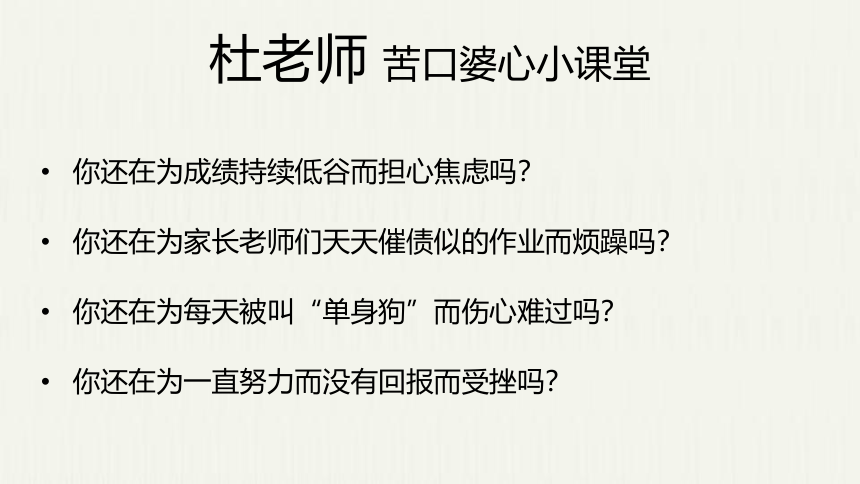

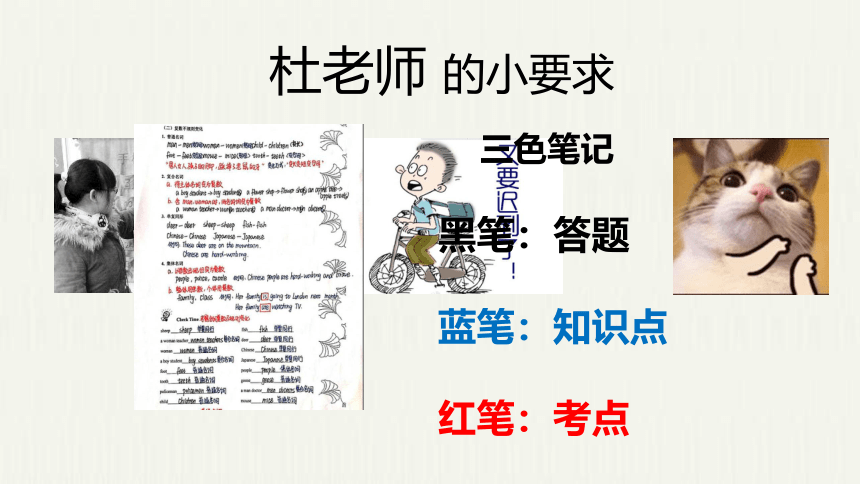
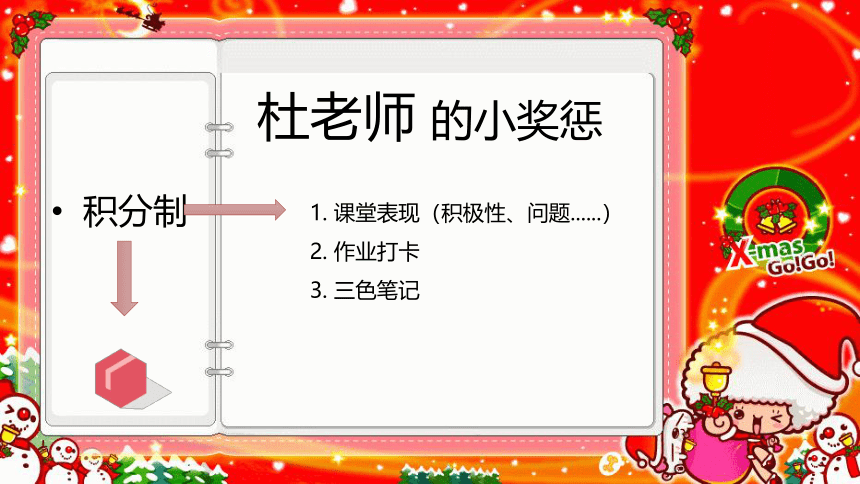

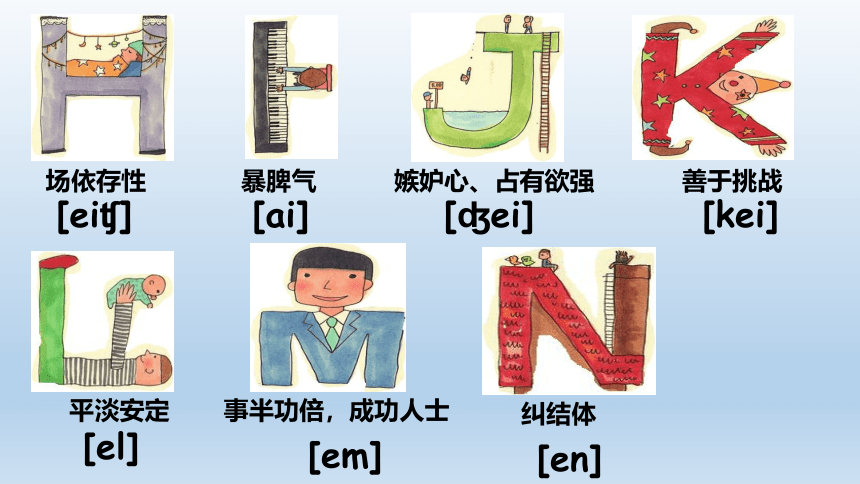
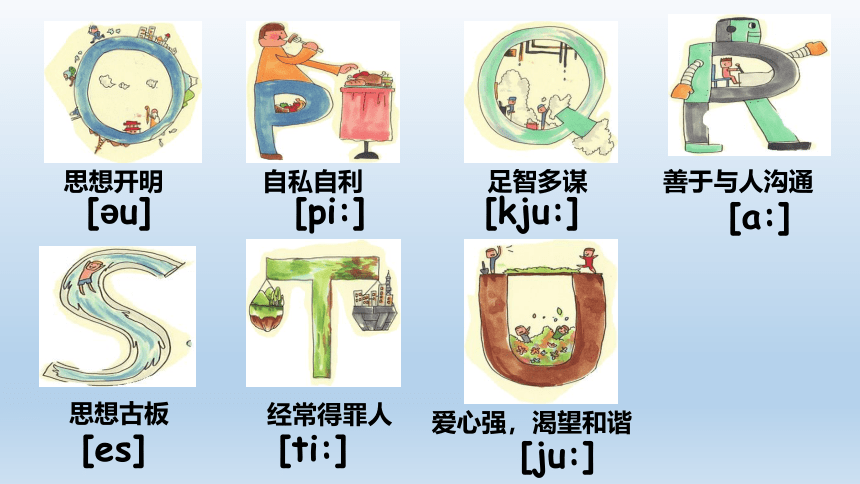
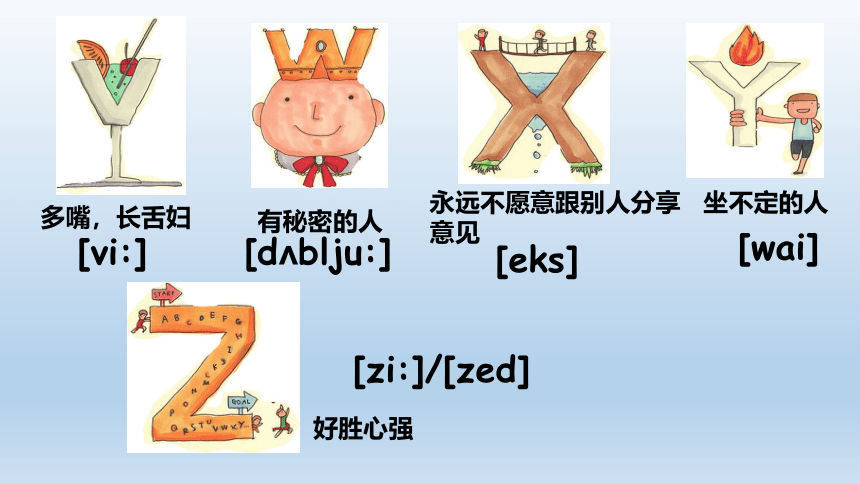

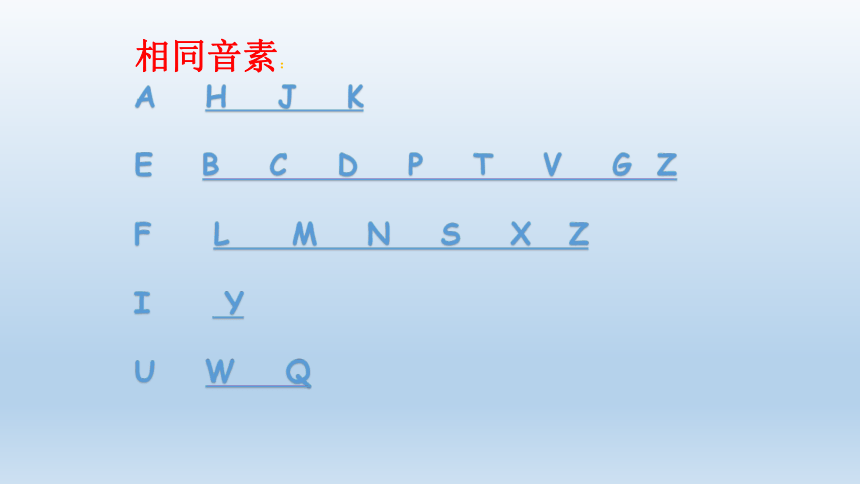
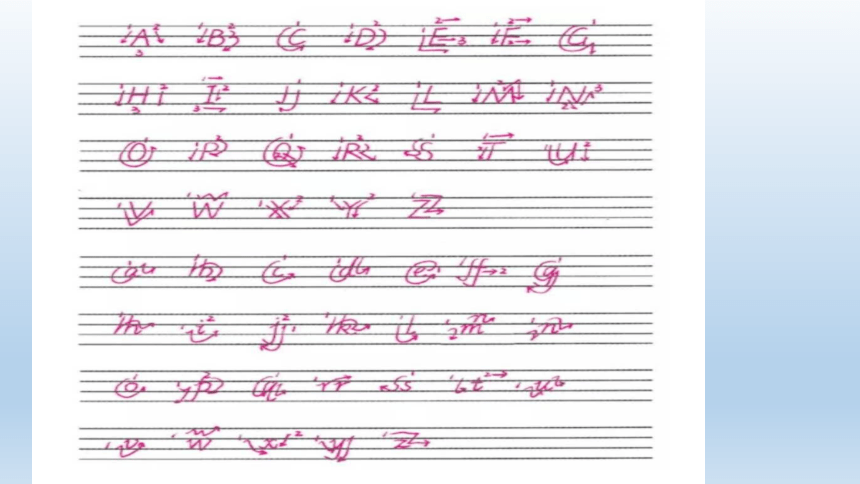
文档简介
(共45张PPT)
新初一
UNIT1.
杜老师
苦口婆心小课堂
你还在为成绩持续低谷而担心焦虑吗?
你还在为家长老师们天天催债似的作业而烦躁吗?
你还在为每天被叫“单身狗”而伤心难过吗?
你还在为一直努力而没有回报而受挫吗?
杜老师
的小建议
不要在课堂上吃饭、睡觉、打豆豆;
理想
现实
杜老师
的小要求
黑笔:答题
蓝笔:知识点
红笔:考点
三色笔记
积分制
杜老师
的小奖惩
1.
课堂表现(积极性、问题......)
2.
作业打卡
3.
三色笔记
[ei]
[bi:]
[si:]
[di:]
[i:]
[ef]
[?i:]
沉默的思考者
交际谨慎
有野心
很难相信别人
勇于面对挑战
追求者很多
成熟,观察细致
[ai]
[?ei]
[kei]
[el]
[em]
[en]
[ei?]
场依存性
暴脾气
嫉妒心、占有欲强
善于挑战
平淡安定
事半功倍,成功人士
纠结体
[kju:]
[a:]
[es]
[ti:]
[ju:]
[pi:]
[?u]
思想开明
自私自利
足智多谋
善于与人沟通
思想古板
经常得罪人
爱心强,渴望和谐
[wai]
[zi:]/[zed]
[eks]
[vi:]
[d?blju:]
多嘴,长舌妇
有秘密的人
永远不愿意跟别人分享意见
坐不定的人
好胜心强
[em]
[‘d?blju:]
[si:]
[i:]
[eks]
[di:][kei][el][wai][ai][zed]
[a:]
[bi:]
[ju:]
[zi:]
[ti:]
[d?ei]
[d?i:]
[?u]
[ef]
[ei]
[vi:]
[en][kju:][pi:]:[eit?]
[es]
相同音素:
A
H
J
K
E
B
C
D
P
T
V
G
Z
F
L
M
N
S
X
Z
I
Y
U
W
Q
Greetings
如何和美国人打招呼呢?
Long
time
no
see
!
What
else?
How
are
you?
I'm
fine.
I'm
not
bad.
I'm
all
right.
I'm
awful.
I'm
just
so
so.
I'm
very
well.
Everything
goes
well.
How
is
your
father?
He
is
fine.
He
is
not
bad.
He
is
all
right.
He
is
awful.
He
is
just
so
so.
He
is
very
well.
Everything
goes
well.
in
Class
Four在四班
in
为介词,表示“在……里”。class“班级”,表示“几班”时用
“班级(第一个字母必须大写)+基数词(第一个字母必须大写)”。
eg:Class
1=Class
One一班
1
表示在几年级几班
三年级二班
eg:Class
Two,Grade
Three.
。
考向一【易错点】
知识点
考向二
指课程或具体的某节课。
eg:I
have
six
classes
a
day.
我一天有六节课。
考向三
指班上的全体同学。
eg:Hello!Class!
同学们好!
Who+be+...?是询问某人是谁的特殊疑问句,意为“……是谁?”
2
知识点
who是疑问代词,意为“谁”,放在句首。
考向
典例
—________is
that
man
over
there?
—He
is
Dick’s
uncle.
A.Where
B.What
C.Who
D.Which
where“哪儿”,问地点;what“什么”,问事物;who“谁”,问人物;which“哪一个”。
What’s
her
name?
,意为“她叫什么名字?”。
询问男性第三者姓名时用“What’s
his
name?”。
知识点
3
What’s
her/his
name?的答语用:
Her
/
His
name
is...或She
/
He
is...,
意为“她的/他的名字是……”。
考向一
考向二【难点】
辨析she和her,he
和his
?
词义
词性
用法
例句
女性
she
她?
?人称代词主格
?单独用在句中作主语
?She
is
a
student.
她是一名学生。
her
她的
形容词性物主代词
后面加名词
Her
name
is
Lucy.
她的名字是露西
。
她
人称代词宾格
单独用于动词或介词之后
Look
at
her.
看着她。
男性
he
他
人称代词主格
单独用在句中作主语
He
is
a
boy.
他是一个男孩。
his
他的
形容词性物主代词
后面加名词
His
name
is
Tom.
他的名字是汤姆。
1.The
students
are
helping
the
old
man
clean
________
house
now.
A.her B.him C.His
2.—Good
morning,
Miss
Zhang!
—________!
A.Good
morning
B.Good
afternoon
C.Good
evening
D.Good
night
3.—Where
are
the
kids?
—They're
playing
soccer.
You
know,
it's
_____
hobby.
A.
his
B.
her
C.
their
典例
C
A
C
Welcome
to...
意为“欢迎来到……”。
welcome意为“欢迎(光临)”,表示一种亲切的招呼,常用于客人已到达的场合。
知识点
4
考查交际用语。“欢迎来某地”要用“Welcome
to+地点名词”,也可以用“You
are
welcome
to+地点名词”,只是此时welcome用作形容词。
考向一
let
sb.do
sth
.
意为“让某人做某事”,let为使役动词,常用在祈使句中,表示建议。
知识点
5
考向
考查let后加动词原形,人称代词用宾格。
eg:Let
me
help
you.
让我帮你。
show...around意思为“带领……参观”。
eg:Please
show
me
around!
请带我四处参观一下吧!
知识点
6
show
sb
.
sth
.=show
sth.to
sb.
意为“把某物展示给某人看”。
eg:I’ll
show
you
the
book.
=I’ll
show
the
book
to
you.
我将把书拿给你看。
拓展
have
lessons意为“上课”。
知识点
7
也可以说have
a
lesson,lesson前也可以加上某个学科表示“上……课”。lessons也可以换成classes。
eg:I
have
an
English
class
today.
今天我有一节英语课。
We
have
lessons
from
Monday
to
Friday.
=We
have
classes
from
Monday
to
Friday.
我们从周一到周五上课。
考向
play
sports意为“进行体育运动”。
have
fun
意为“过得愉快,玩得高兴”。
知识点
8
考查固定动词短语play
sports和have
fun。
考向一
have
fun与have
a
good
time,enjoy
oneself
同义。
考向二
have
fun后面跟动词的
?ing
形式。
eg:I
have
fun
playing
football.
我享受踢足球的乐趣。
考向三【重点】
They
are
having
great
fun________
(观看)
a
basketball
match
on
TV.
一、单项选择
1.—________
—It's
a
car.
A.What’s
that?
B.Is
it
a
car?
C.Are
they
cars?
D.What
this?
2.Welcome________my
home.
A.to
B.for
C.in
D.On
3.Jenny,________our
school.
A.this
is
B.that
C.this
D.It
4.We
have
English________here.
A.classes'
B.classes
C.lessones
D.lesson
A
A
A
B
play
a
guessing
game
意为“玩猜谜游戏”。
知识点
9
考向一
guessing是guess的动名词,可以位于名词前作定语。
考向二
play
games意为“做游戏”。
eg:I
like
playing
games.
我喜欢做游戏。
Now
it’s
your
turn.现在轮到你了。
这是提醒某人该做某事的句型。
知识点
10
考向
It’s
one’s
turn
to
do
sth.
now.
现在轮到某人做某事了。One’s指形容词性物主代词或名词所有格形式。
eg:It’s
your
turn
to
read
English
now.
现在轮到你读英语了。
It’s
Li
Ming’s
turn
to
play
a
guessing
game
now.现在轮到李明玩猜谜游戏了。
on
the
wall意为“在墙上”,指在墙面上。
知识点
11
考向【易错点】
辨析on
the
wall和in
the
wall
易混短语
用法辨析
例句
on
the
wall
意为“在墙上”,常指图画、地图、黑板等在墙上
There
is
a
beautiful
picture
on
the
wall.
墙上有一张漂亮的图画。
in
the
wall
也指“在墙上”,但强调在墙的里面,常指洞、窗户、门等在墙上
There
is
a
hole
in
the
wall.墙上有一个洞。(洞在墙的里面)
二、单项选择
6.The
blackboard
is________the
wall.
A.in
B.at
C.on
D.To
7.Not
many
people
can
write
________
their
left
hands.
A.in
B.at
C.on
D.With
8.You
can
________
books
from
the
library.
A.
get
B.
getting
C.
gets
D.
to
get
9.—________
you
go
and
buy
some
crayons?
—Sorry,
I
can't.
A.Do
B.Are
C.Can
D.Must
10.Now
it
is________turn
to
sing.
A.my
B.you
C.I
D.he
C
D
A
C
A
may/meI/
v.
aux.
情态动词,没有人称和数的变化,其后必须加动词原形。“May
I...?”是表示请求的句式,主语一般用第一人称I。其结构为“May+主语+动词原形+其他?”。
eg:May
I
come
in?
我可以进来吗?
知识点
12
考向一
考查情态动词may,意为“可以”,表示请求。
—I
hear
you've
got
a
new
iPhone
4S.
________I
have
a
look?
—Yes,certainly.
A.May
B.Do
C.Must
D.Should
典例
A
考向二【易错点】
考查“May
I...?”句型的答语。
其答语有以下几种形式:
肯定形式:OK./Sure./Certainly./Of
course./Yes,
you
may.
否定形式:Sorry./No,you
may
not.
注意:may
not无缩写形式。
eg:—May
I
have
your
ruler?我可以借你的尺子吗?
—OK.
Here
you
are.可以。给你。
—May
I
have
a
pencil?我可以借支铅笔吗?
—Sorry.
I
don’t
have
a
pencil.
很抱歉。我没有铅笔。
You’re
welcome!此句是回应别人致谢时的答语。意为“不用谢、别客气”。
知识点
13
考向
考查回应谢意。
eg:—May
I
have
your
pen?
我可以借你的钢笔吗?
—OK.
Here
you
are.可以。给你。
—Thank
you.谢谢。
—You're
welcome.别客气。
borrow/'b?r??/
v.借,借入,
常和from连用。
eg:—May
I
borrow
your
pencil,Jenny?
詹妮,我可以借你的铅笔吗?
—Yes,you
may.
Here
you
are.
是的,可以。给你。
知识点
14
考向一【重点】
考查borrow...from...
意为“从……借来……”。
We
Chinese
sometimes________(借)words
from
English
when
we
talk.
典例
borrow
考向二
辨析borrow和lend
borrow
指“借入”。“向某人借某物”要用borrow
sth.
from
sb.。
?
lend
指“借出”。“把某物借给某人”要用lend
sth.to
sb.。
get/get/v.买,取,得到
知识点
15
get
sth
.
for
sb.
为某人取/买/拿某物
eg:I
can
get
a
book
for
you.
=I
can
buy
a
book
for
you.
我能为你买一本书。
考向
eg:Can
you
get
some
water
for
me?
你能为我取一些水来吗?
二、用some或any填空
6.There
is
________
milk
in
the
fridge.
7.There
aren't
_______boys
in
my
family.
8.It's
good
for
children
to
eat
______
fresh(新鲜的)
fruit
every
day.
9.Are
there
________
flowers
in
your
classroom?
10.—Would
you
like
________
orange
juice(果汁)?
—Yes,
please.
some
any
16.
:some和any的考向:some一般用在肯定句中,any一般用在否定句和疑问句中;some用于疑问句中,表示希望得到对方的肯定回答。
some
any
some
What
about...?
此句式主要用于表示询问、请求或建议。
它的同义句式是“How
about
...?”。
知识点
17
What
about...?“……怎么样/如何?”about
是介词,后跟名词、代词或
动名词。
—What
about
________(take)
a
rest?
—OK.
Let's
go
out
and
have
a
walk.
考向【易错点】
need意为“需要”,在此处是实义动词。
知识点
18
考向一
表示“需要某物”可用“need
sth.”。
eg:All
plants
need
water
and
sunlight.
所有的植物都需要水和阳光。
考向二
表示“需要做某事”,可用need
to
do
sth.。
eg:We
need
to
go
out
now.
我们需要现在出去。
考向三
表示“需要某人做某事”,可用need
sb.
to
do
sth.。
eg:I
need
him
to
get
a
book
for
me.
我需要他为我买本书。
He
needs
________(buy)
many
things
today.
典例
to
buy
Be动词
考向一、主语与be动词的搭配
考向二、be
动词在一般现在时的句型
肯定句:
否定句:
一般疑问句:
特殊疑问句:
主语+be+其他
主语+be+not+其他
Be+主语+其他?
特殊疑问词+be+主语+其他?
3.be+介词短语
1.be+形容词
4.be+副词
考向三、be动词的用法
2.be+名词
一.用be动词适当的词填空。?
1.?I?________?from?Australia.?
2.?She?_______??a?student.?
3.Jane?and?Tom?_________?my?friends.?
4.?My?parents?_______??very?busy?every?day.?
5.I?______?an?English?teacher?now.?
6.Where??_________??you?from??
7.The?light??_________??green.?
8.My?name?is?_________??Li?Dong.
I?_________?twelve.?9._________?they?your?new?friends??
10.?I?______?a?boy.?______?you?a?boy??No,?I?_____?not.?
11.?The?girl______?Jack's?sister.?
12.?The?dog?_______?tall?and?fat.
Thank
you!
新初一
UNIT1.
杜老师
苦口婆心小课堂
你还在为成绩持续低谷而担心焦虑吗?
你还在为家长老师们天天催债似的作业而烦躁吗?
你还在为每天被叫“单身狗”而伤心难过吗?
你还在为一直努力而没有回报而受挫吗?
杜老师
的小建议
不要在课堂上吃饭、睡觉、打豆豆;
理想
现实
杜老师
的小要求
黑笔:答题
蓝笔:知识点
红笔:考点
三色笔记
积分制
杜老师
的小奖惩
1.
课堂表现(积极性、问题......)
2.
作业打卡
3.
三色笔记
[ei]
[bi:]
[si:]
[di:]
[i:]
[ef]
[?i:]
沉默的思考者
交际谨慎
有野心
很难相信别人
勇于面对挑战
追求者很多
成熟,观察细致
[ai]
[?ei]
[kei]
[el]
[em]
[en]
[ei?]
场依存性
暴脾气
嫉妒心、占有欲强
善于挑战
平淡安定
事半功倍,成功人士
纠结体
[kju:]
[a:]
[es]
[ti:]
[ju:]
[pi:]
[?u]
思想开明
自私自利
足智多谋
善于与人沟通
思想古板
经常得罪人
爱心强,渴望和谐
[wai]
[zi:]/[zed]
[eks]
[vi:]
[d?blju:]
多嘴,长舌妇
有秘密的人
永远不愿意跟别人分享意见
坐不定的人
好胜心强
[em]
[‘d?blju:]
[si:]
[i:]
[eks]
[di:][kei][el][wai][ai][zed]
[a:]
[bi:]
[ju:]
[zi:]
[ti:]
[d?ei]
[d?i:]
[?u]
[ef]
[ei]
[vi:]
[en][kju:][pi:]:[eit?]
[es]
相同音素:
A
H
J
K
E
B
C
D
P
T
V
G
Z
F
L
M
N
S
X
Z
I
Y
U
W
Q
Greetings
如何和美国人打招呼呢?
Long
time
no
see
!
What
else?
How
are
you?
I'm
fine.
I'm
not
bad.
I'm
all
right.
I'm
awful.
I'm
just
so
so.
I'm
very
well.
Everything
goes
well.
How
is
your
father?
He
is
fine.
He
is
not
bad.
He
is
all
right.
He
is
awful.
He
is
just
so
so.
He
is
very
well.
Everything
goes
well.
in
Class
Four在四班
in
为介词,表示“在……里”。class“班级”,表示“几班”时用
“班级(第一个字母必须大写)+基数词(第一个字母必须大写)”。
eg:Class
1=Class
One一班
1
表示在几年级几班
三年级二班
eg:Class
Two,Grade
Three.
。
考向一【易错点】
知识点
考向二
指课程或具体的某节课。
eg:I
have
six
classes
a
day.
我一天有六节课。
考向三
指班上的全体同学。
eg:Hello!Class!
同学们好!
Who+be+...?是询问某人是谁的特殊疑问句,意为“……是谁?”
2
知识点
who是疑问代词,意为“谁”,放在句首。
考向
典例
—________is
that
man
over
there?
—He
is
Dick’s
uncle.
A.Where
B.What
C.Who
D.Which
where“哪儿”,问地点;what“什么”,问事物;who“谁”,问人物;which“哪一个”。
What’s
her
name?
,意为“她叫什么名字?”。
询问男性第三者姓名时用“What’s
his
name?”。
知识点
3
What’s
her/his
name?的答语用:
Her
/
His
name
is...或She
/
He
is...,
意为“她的/他的名字是……”。
考向一
考向二【难点】
辨析she和her,he
和his
?
词义
词性
用法
例句
女性
she
她?
?人称代词主格
?单独用在句中作主语
?She
is
a
student.
她是一名学生。
her
她的
形容词性物主代词
后面加名词
Her
name
is
Lucy.
她的名字是露西
。
她
人称代词宾格
单独用于动词或介词之后
Look
at
her.
看着她。
男性
he
他
人称代词主格
单独用在句中作主语
He
is
a
boy.
他是一个男孩。
his
他的
形容词性物主代词
后面加名词
His
name
is
Tom.
他的名字是汤姆。
1.The
students
are
helping
the
old
man
clean
________
house
now.
A.her B.him C.His
2.—Good
morning,
Miss
Zhang!
—________!
A.Good
morning
B.Good
afternoon
C.Good
evening
D.Good
night
3.—Where
are
the
kids?
—They're
playing
soccer.
You
know,
it's
_____
hobby.
A.
his
B.
her
C.
their
典例
C
A
C
Welcome
to...
意为“欢迎来到……”。
welcome意为“欢迎(光临)”,表示一种亲切的招呼,常用于客人已到达的场合。
知识点
4
考查交际用语。“欢迎来某地”要用“Welcome
to+地点名词”,也可以用“You
are
welcome
to+地点名词”,只是此时welcome用作形容词。
考向一
let
sb.do
sth
.
意为“让某人做某事”,let为使役动词,常用在祈使句中,表示建议。
知识点
5
考向
考查let后加动词原形,人称代词用宾格。
eg:Let
me
help
you.
让我帮你。
show...around意思为“带领……参观”。
eg:Please
show
me
around!
请带我四处参观一下吧!
知识点
6
show
sb
.
sth
.=show
sth.to
sb.
意为“把某物展示给某人看”。
eg:I’ll
show
you
the
book.
=I’ll
show
the
book
to
you.
我将把书拿给你看。
拓展
have
lessons意为“上课”。
知识点
7
也可以说have
a
lesson,lesson前也可以加上某个学科表示“上……课”。lessons也可以换成classes。
eg:I
have
an
English
class
today.
今天我有一节英语课。
We
have
lessons
from
Monday
to
Friday.
=We
have
classes
from
Monday
to
Friday.
我们从周一到周五上课。
考向
play
sports意为“进行体育运动”。
have
fun
意为“过得愉快,玩得高兴”。
知识点
8
考查固定动词短语play
sports和have
fun。
考向一
have
fun与have
a
good
time,enjoy
oneself
同义。
考向二
have
fun后面跟动词的
?ing
形式。
eg:I
have
fun
playing
football.
我享受踢足球的乐趣。
考向三【重点】
They
are
having
great
fun________
(观看)
a
basketball
match
on
TV.
一、单项选择
1.—________
—It's
a
car.
A.What’s
that?
B.Is
it
a
car?
C.Are
they
cars?
D.What
this?
2.Welcome________my
home.
A.to
B.for
C.in
D.On
3.Jenny,________our
school.
A.this
is
B.that
C.this
D.It
4.We
have
English________here.
A.classes'
B.classes
C.lessones
D.lesson
A
A
A
B
play
a
guessing
game
意为“玩猜谜游戏”。
知识点
9
考向一
guessing是guess的动名词,可以位于名词前作定语。
考向二
play
games意为“做游戏”。
eg:I
like
playing
games.
我喜欢做游戏。
Now
it’s
your
turn.现在轮到你了。
这是提醒某人该做某事的句型。
知识点
10
考向
It’s
one’s
turn
to
do
sth.
now.
现在轮到某人做某事了。One’s指形容词性物主代词或名词所有格形式。
eg:It’s
your
turn
to
read
English
now.
现在轮到你读英语了。
It’s
Li
Ming’s
turn
to
play
a
guessing
game
now.现在轮到李明玩猜谜游戏了。
on
the
wall意为“在墙上”,指在墙面上。
知识点
11
考向【易错点】
辨析on
the
wall和in
the
wall
易混短语
用法辨析
例句
on
the
wall
意为“在墙上”,常指图画、地图、黑板等在墙上
There
is
a
beautiful
picture
on
the
wall.
墙上有一张漂亮的图画。
in
the
wall
也指“在墙上”,但强调在墙的里面,常指洞、窗户、门等在墙上
There
is
a
hole
in
the
wall.墙上有一个洞。(洞在墙的里面)
二、单项选择
6.The
blackboard
is________the
wall.
A.in
B.at
C.on
D.To
7.Not
many
people
can
write
________
their
left
hands.
A.in
B.at
C.on
D.With
8.You
can
________
books
from
the
library.
A.
get
B.
getting
C.
gets
D.
to
get
9.—________
you
go
and
buy
some
crayons?
—Sorry,
I
can't.
A.Do
B.Are
C.Can
D.Must
10.Now
it
is________turn
to
sing.
A.my
B.you
C.I
D.he
C
D
A
C
A
may/meI/
v.
aux.
情态动词,没有人称和数的变化,其后必须加动词原形。“May
I...?”是表示请求的句式,主语一般用第一人称I。其结构为“May+主语+动词原形+其他?”。
eg:May
I
come
in?
我可以进来吗?
知识点
12
考向一
考查情态动词may,意为“可以”,表示请求。
—I
hear
you've
got
a
new
iPhone
4S.
________I
have
a
look?
—Yes,certainly.
A.May
B.Do
C.Must
D.Should
典例
A
考向二【易错点】
考查“May
I...?”句型的答语。
其答语有以下几种形式:
肯定形式:OK./Sure./Certainly./Of
course./Yes,
you
may.
否定形式:Sorry./No,you
may
not.
注意:may
not无缩写形式。
eg:—May
I
have
your
ruler?我可以借你的尺子吗?
—OK.
Here
you
are.可以。给你。
—May
I
have
a
pencil?我可以借支铅笔吗?
—Sorry.
I
don’t
have
a
pencil.
很抱歉。我没有铅笔。
You’re
welcome!此句是回应别人致谢时的答语。意为“不用谢、别客气”。
知识点
13
考向
考查回应谢意。
eg:—May
I
have
your
pen?
我可以借你的钢笔吗?
—OK.
Here
you
are.可以。给你。
—Thank
you.谢谢。
—You're
welcome.别客气。
borrow/'b?r??/
v.借,借入,
常和from连用。
eg:—May
I
borrow
your
pencil,Jenny?
詹妮,我可以借你的铅笔吗?
—Yes,you
may.
Here
you
are.
是的,可以。给你。
知识点
14
考向一【重点】
考查borrow...from...
意为“从……借来……”。
We
Chinese
sometimes________(借)words
from
English
when
we
talk.
典例
borrow
考向二
辨析borrow和lend
borrow
指“借入”。“向某人借某物”要用borrow
sth.
from
sb.。
?
lend
指“借出”。“把某物借给某人”要用lend
sth.to
sb.。
get/get/v.买,取,得到
知识点
15
get
sth
.
for
sb.
为某人取/买/拿某物
eg:I
can
get
a
book
for
you.
=I
can
buy
a
book
for
you.
我能为你买一本书。
考向
eg:Can
you
get
some
water
for
me?
你能为我取一些水来吗?
二、用some或any填空
6.There
is
________
milk
in
the
fridge.
7.There
aren't
_______boys
in
my
family.
8.It's
good
for
children
to
eat
______
fresh(新鲜的)
fruit
every
day.
9.Are
there
________
flowers
in
your
classroom?
10.—Would
you
like
________
orange
juice(果汁)?
—Yes,
please.
some
any
16.
:some和any的考向:some一般用在肯定句中,any一般用在否定句和疑问句中;some用于疑问句中,表示希望得到对方的肯定回答。
some
any
some
What
about...?
此句式主要用于表示询问、请求或建议。
它的同义句式是“How
about
...?”。
知识点
17
What
about...?“……怎么样/如何?”about
是介词,后跟名词、代词或
动名词。
—What
about
________(take)
a
rest?
—OK.
Let's
go
out
and
have
a
walk.
考向【易错点】
need意为“需要”,在此处是实义动词。
知识点
18
考向一
表示“需要某物”可用“need
sth.”。
eg:All
plants
need
water
and
sunlight.
所有的植物都需要水和阳光。
考向二
表示“需要做某事”,可用need
to
do
sth.。
eg:We
need
to
go
out
now.
我们需要现在出去。
考向三
表示“需要某人做某事”,可用need
sb.
to
do
sth.。
eg:I
need
him
to
get
a
book
for
me.
我需要他为我买本书。
He
needs
________(buy)
many
things
today.
典例
to
buy
Be动词
考向一、主语与be动词的搭配
考向二、be
动词在一般现在时的句型
肯定句:
否定句:
一般疑问句:
特殊疑问句:
主语+be+其他
主语+be+not+其他
Be+主语+其他?
特殊疑问词+be+主语+其他?
3.be+介词短语
1.be+形容词
4.be+副词
考向三、be动词的用法
2.be+名词
一.用be动词适当的词填空。?
1.?I?________?from?Australia.?
2.?She?_______??a?student.?
3.Jane?and?Tom?_________?my?friends.?
4.?My?parents?_______??very?busy?every?day.?
5.I?______?an?English?teacher?now.?
6.Where??_________??you?from??
7.The?light??_________??green.?
8.My?name?is?_________??Li?Dong.
I?_________?twelve.?9._________?they?your?new?friends??
10.?I?______?a?boy.?______?you?a?boy??No,?I?_____?not.?
11.?The?girl______?Jack's?sister.?
12.?The?dog?_______?tall?and?fat.
Thank
you!
同课章节目录
- Unit 1 School and friends
- Lesson 1 Hello!
- Lesson 2 Teacher and Students
- Lesson 3 Welcome to Our School
- Lesson 4 What Is It?
- Lesson 5 May I Have a Book?
- Lesson 6 Things for School
- Unit 2 Colours and Clothes
- Lesson 7 Jenny's New Skirt
- Lesson 8 Danny's Favourit Colou
- Lesson 9 Whose Coat Is This?
- Lesson 10 Clothes for a Cold Day
- Lesson 11 Clothes around the World
- Lesson 12 Let's Go Shopping!
- Unit 3 Body Parts and Feelings
- Lesson 13 Body Parts
- Lesson 14 Colours and Feelings
- Lesson 15 Tall or Short
- Lesson 16 Happy or Sad
- Lesson 17 Seeing a Docto
- Lesson 18 We All Look Different!
- Unit 4 Food and Restaurants
- Lesson 19 Time for Breakfast!
- Lesson 20 I Like the Supermarket!
- Lesson 21 At the Market
- Lesson 22 In the Restaurant
- Lesson 23 The Corner Store
- Lesson 24 Eat Good Food!
- Unit 5 Family and Home
- Lesson 25 Jenny's Family
- Lesson 26 Li Ming's Family
- Lesson 27 Danny at Home
- Lesson 28 A Family Picnic
- Lesson 29 A Birthday Card
- Lesson 30 Grandma's Birthday Party
- Unit 6 Let's Go!
- Lesson 31 Let's Go to the Bookstore!
- Lesson 32 At the Supermarket
- Lesson 33 Let's Go to the Zoo!
- Lesson 34 On the Farm
- Lesson 35 Let's Go to the Museum!
- Lesson 36 Let's Go to the Movie Theatre!
- Unit 7 Days and Months
- Lesson 37 Seasons and Weathe
- Lesson 38 Nick's Busy Month
- Lesson 39 A Class Calenda
- Lesson 40 When Is Your Birthday?
- Lesson 41 Holidays
- Lesson 42 Happy Holidays!
- Unit 8 Countries around the world
- Lesson 43 Directions
- Lesson 44 Jack's Goodbye Party
- Lesson 45 China
- Lesson 46 Canada and the U.S.
- Lesson 47 The U.K. and Australia
- Lesson 48 English-Speaking Countries
